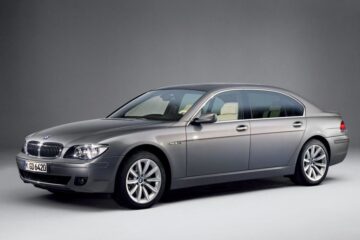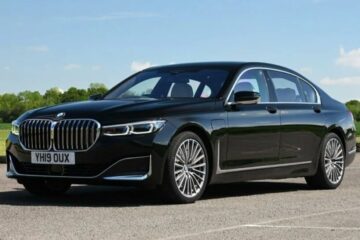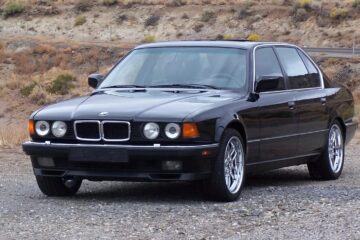The official debut of the Bavarian flagship model BMW 7 Series F01-F04 debuted at the Paris Motor Show in 2008. The factory designation of the car is F01 (there was also an extended version, which received the designation F02). At the Moscow Motor Show in 2012, the Germans presented an updated version of this car, which was characterized by a modified exterior and modernization of the interior.
Exterior
Many fans of the company are ambivalent about the appearance of the BMW 7 F01 and F02, which is justified. If you do not go into details and conduct a simple review, it may seem that this is a slightly enlarged model of the fifth series. But on the other hand, the high status and solidity of the model is confirmed, as the flagship sedan has a heavy and rough shape. It is thanks to this design approach that the car gained its popularity, and also began to stand out from the rest.
The BMW 730d F01’s appearance is characterized by details that form a complete image. The headlights are made in the usual LED design, the signature radiator grille, relief bumpers and LED taillights give sportiness and solidity. Completing the assertive image of the Bavarian are the wheels, the size of which can be from 17 to 21 inches.
The front bumper of the BMW 7 series F01 looks quite massive, and it houses the trademark chrome grille, which is also quite large. In the lower part there are air intakes, various chrome inserts and small fog lights.
In the photo of the BMW F01, it is noticeable that the side of the car does not contain elements that can immediately catch the eye, as it is executed in a fairly simple style. The top of the body area is decorated with a flamboyant line that starts from the front and ends at the rear optics. Wheel arches are traditionally distinguished by small extensions with the usual beveling. In the area of the front door there is a decorative insert of chrome. The door handles and window trims are also finished in chrome.
Rear headlights are also equipped with LED optics, and their style of execution does not depart from the traditions of the Bavarians. The trunk lid is very large and it is complemented by a chrome spoiler. Reviews of owners about BMW F01 give the notion that the dimensions do not bring problems, since there is an electric drive. The rear bumper is not distinguished by small dimensions, and it also placed on itself narrow light reflectors, which are connected by a line of chrome. In the lower part, the exhaust system pipes are embedded, while they do not affect the overall appearance of the bumper in any way.
The exterior of the BMW 740 F01 can be considered a success, as the car looks serious and expensive, despite being somewhat similar to the previous model. External tuning of the BMW F01 is not necessary, as the sedan has a rather attractive appearance from the factory. Dimensions have also succumbed to changes: the length of the body is 5079 millimeters with a width of 1902 millimeters. At the same time, the Bavarians have kept the height at 1471 millimeters, and the wheelbase is 3070 millimeters of the total body length. Ground clearance is 152 millimeters.
In the model range there was also an extended version of the car, the so-called Long, which received the marking F02, its dimensions were as follows: the length was 5219 millimeters, the wheelbase was 3210 millimeters, and the width was 1902 millimeters at the same height and ground clearance.
Interior
Inside, the car looks just perfect. Every single element was made of high-quality materials according to the tradition of the Bavarian manufacturer, so the interior of BMW F01 immediately mesmerizes the owners. Natural leather was used to cover the seats. The seats were equipped with a ventilation and heating system, as well as the possibility of electric adjustment.
The BMW 750li F01 extended model features a button that allows the front seat to be folded down and the footwell to be extended. These versions of the cars are designed for an executive target audience that will travel in the back seat, so you can rest easy during long trips. The multimedia and climate control system in the sedan is also present. The steering wheel of the BMW 750 F01 is fully covered in high-quality leather, and it houses an electric device for controlling the multimedia system. The dashboard houses a display that creates a simulation of analog gauges that display the necessary information for comfortable driving.
On the center console there is a seven-inch display of navigation and multimedia system. In terms of options, this unit is almost identical to its ten-inch counterpart. The lower part of the console, located in the center, does not bring novelty – everything is made there in classic solutions for BMW. It is a place for installation of radio control units and climate control unit.
The tunnel of the BMW 740d F01 placed a niche with cup holders, which have a built-in function to heat or cool drinks. The gearbox selector was again installed in a familiar place, but it was small in size. On the left side of the handle there are switches of speed modes and a button responsible for disabling the stability control system (ESP). On the right side there is a small puck, which allows controlling the multimedia system. A massive armrest completes the whole folded composition. Not insignificant is also the luggage compartment, to which in BMW traditionally pay much attention. The new model received the same execution as the previous generations of the seventh series. Useful space of the luggage compartment is 500 liters when filled to the level of the windows.
The interior is fully upholstered in genuine high quality leather, and wooden and chrome inserts are used as additional decorative elements. Buyers can choose the shade of finishing materials based on their own preferences.
Features
The fifth generation BMW 7 series does not stand out with a special suspension design, everything is made according to the classics – in the front two levers and in the rear four. The chassis also consists of active stabilizers together with shock absorbers, which have separate compression and rebound adjustments in real time. All four wheels have disc brakes on all four wheels, which are individually ventilated.
In the lineup of the family of the seventh series are not only standard versions, but there are also a few specific modifications. One of these variants is an armored car High Security, which received the production index F03. When manufacturing the model, the designers managed to achieve compliance with the standards of protection class VR7, and parts of the body in case of horizontal firing can withstand loads of class VR9. In simple words, in such a car passengers will not be able to hit from rifles and automatic rifles with caliber 7.62 millimeters. Armored version of the seven has a greater weight, which is 3825 kilograms. The entire structure is powered by a 544 horsepower V-12 cylinder engine. The model is able to accelerate to the first hundred in just 6.2 seconds, with a top speed of 210 kilometers per hour.
There was also a limited version of the ActiveHybrid7, which was given the index F04. This version is powered by an eight-cylinder V engine equipped with two additional superchargers that contribute to the output of 440 horsepower. Working together is a 20-horsepower electric motor. Working in tandem, the motors are able to accelerate the executive sedan to the first hundred in 4.8 seconds, with a top speed of 240 km / h. Compared to conventional gasoline versions, this modification is able to provide fuel consumption 15% less than the classic BMW F01.
Engines
On the 750i models of the seventh series, a twin-turbo motor with eight cylinders was installed. Its working volume was 4.4 liters, and it is capable of developing up to 408 horsepower (after restyling, the power was increased to 449 hp). This is the most common version of the powertrain, which is able to provide the sedan dialing the first hundred in just 5.2 seconds.
The N54 motors were located in the BMW 740i F01. They are three-liter motors with six cylinders arranged in a row. Thanks to the installation of two additional superchargers in the form of turbines, it was possible to squeeze out 326 horses from it. After restyling, the models began to install a power unit N55 for 320 horsepower. This is a modification of the R6 motor, which differed by installing one turbine on two chambers and the Valvetronic system, which provides changes in the height of the intake valve lift.
The performance of the BMW F01 version 760 Li was provided by the installation of the top-end twin-turbo powertrain – N74. It is a six-liter motor, which provided for the installation of 12 cylinders and produced up to 544 horsepower with a maximum torque of 750 Nm.
The 730i and 730d versions were equipped with engines that fully corresponded to their index. Under the hood of the first version could be found an atmospheric gasoline motor N52 for three liters of working volume, providing specifications of 258 horsepower of power. The second modification had a turbocharged diesel engine N57, and it was a BMW F01 3.0 d, developing a power of 245 horses.
BMW F01 diesel, specifically the 740d and 750d models were equipped with N57 diesel powertrains that were paired with twin or triple turbos respectively.
The biggest problems are given to its owners by the modification 750i, under the hood of which there is a motor N63. The minuses of the power unit consisted in the fact that two turbines, a pair of exhaust manifolds and a pair of catalytic converters are installed directly in the collapse of the cylinder block. This results in a lot of heat during operation. As a result, the powertrain is very heat stressed. As a result of such interactions after 100 thousand kilometers, the oil caps fail, this entails oil skipping. Increased consumption of lubricating fluid leads to contamination of valves with soot and piston rings. Users notice that oil consumption rises to 1.5 liters for every 1000 kilometers.
The tubes that supply lubricant to the turbines also begin to gradually clog, and the price of an original new turbine is very high. Vacuum tubes, as well as rubber and plastic parts of the cooling system are affected by high temperatures and quickly fail.
Users of BMWs with such motors are of the opinion that it is better not to wait for a malfunction, but to replace the oil caps after every 80 thousand kilometers of mileage. Also, experts cite recommendations to install cooler thermostats for coolants and oil. It is recommended to change lubricating fluids as often as possible, and keep radiators clean. If you do not pay attention to increased oil consumption, then after 100 thousand kilometers of mileage may require major engine overhaul, which costs a considerable amount of money. The motor likes high speeds, so it is necessary to get out on country roads as often as possible and “grind” the engine well.
Motor N74, installed on the modification 760i provides for the absence of common problems due to high thermal loads, because the turbines together with catalytic converters are removed from the block. But the greater number of cylinders may entail higher repair costs.
Models 740i, placing under the hood power units N54B30O0 usually make you pay attention after 150 thousand kilometers of mileage, less often they pass about 200 thousand. The most vulnerable places of such engines are considered: high-pressure fuel pump, superchargers, ignition coils and the valve of the Vanos system. After restyling on this modification began to install motors N55, which are characterized by increased oil consumption. This is caused by the crankcase gas ventilation valve, which is constantly clogged with slag. The high-pressure fuel pump and injectors are also not particularly reliable.
The most reliable among gasoline engines is considered to be the atmospheric power unit N52, installed on the modification 730i. Therefore, problems with BMW F01 of this modification arise extremely rarely. Diesel motors N57 suffer wear of the crankshaft damper pulley and plastic gear of the throttle unit after passing 200 thousand kilometers. The high-pressure fuel pump can also fail between 150,000 and 250,000 kilometers.
After overcoming 200-250 thousand kilometers, there is also a need to go to the service to replace the stretched timing chain. Since this node is located at the rear of the engine, it is necessary to pull out the power unit, which significantly increases the cost of repair. In the 740d version with more power, the chain drive can break without any signs for the owner. The superchargers in the N57 series diesel powertrains are characterized by long life. Only faulty vacuum hoses or converters can cause breakdowns or unstable operation.
Options
The standard equipment of the BMW F07 is quite rich and provides for the installation of electric power steering, air suspension, transverse stability system of the car, anti-lock braking system and six airbags. Climate control system, light, rain and tire pressure sensors, full electric package, alloy wheels, adaptive cruise control and push-button engine start system also please the owners of the seven as standard.
Differences between restyling and prerestyling
In May 2012, the Bavarians presented BMW F01 restyling. The updated car immediately catches the eye, so it is very easy to identify it among the older versions, as the prerestyling had a lot of differences.
The most notable feature is the updated headlights, restyled headlights were diode. The restyled grille received nine vertical partitions, instead of the usual twelve. Side mirrors and bumpers became equipped with turn signal repeaters.
The interior design of the sedan has also been given some effort, but much less. The instrument panel became fully digital, and the seats got a slightly different shape. Otherwise, the model remains the same. Therefore, it is possible to answer the question what has changed without special problems.
Generations and configurations
Sedan 5th generation – restyling
07.2012 – 07.2015
| 730i AT | N52B30 | 3.0l | 258 hp |
| 730Li AT | N52B30 | 3.0L | 258 hp |
| 740Li AT xDrive | N55B30 | 3.0L | 320 hp |
| 730d AT xDrive | N57D30 | 3.0L | 258 hp |
| 730d AT Base | N57D30 | 3.0L | 258 hp |
| 730Ld AT Base | N57D30 | 3.0L | 258 hp |
| 740d AT xDrive Base | N57D30TOP | 3.0L | 313 hp |
| 750d AT xDrive Base | N57D30TOP | 3.0L | 381 hp |
| 750Ld AT xDrive | N57D30TOP | 3.0L | 381 hp |
| 750i AT xDrive Base | N63B44Tu | 4.4l | 449 hp |
| 750Li AT xDrive | N63B44Tu | 4.4L | 449 hp |
| 760i AT Base | N74B60 | 6.0l | 544 hp |
| 760Li AT | N74B60 | 6.0L | 544 hp |
Sedan, 5th generation hybrid
07.2008 – 07.2012
| 730i AT Base | N52B30 | 3.0L | 258 hp |
| 730Li AT Base | N52B30 | 3.0L | 258 hp |
| 740i AT Base | N55B30 | 3.0L | 326 hp |
| 740Li AT Base | N55B30 | 3.0L | 326 hp |
| 730d AT Base | N57D30 | 3.0L | 245 hp |
| 730Ld AT Base | N57D30 | 3.0L | 245 hp |
| 740d AT xDrive Base | N57D30TOP | 3.0L | 306 hp |
| 750Li AT xDrive Business Edition | N63B44 | 4.4L | 407 hp |
| 750i AT xDrive Base | N63B44 | 4.4l | 407 hp |
| 750Li AT xDrive Base | N63B44 | 4.4L | 407 hp |
| 750i AT Base | N63B44 | 4.4l | 407 hp |
| 750Li AT Base | N63B44 | 4.4L | 407 hp |
| ActiveHybrid 7 AT Base | N63B44 | 4.4l | 445 hp |
| ActiveHybrid 7L AT Base | N63B44 | 4.4L | 445 hp |
| 760i AT Base | N74B60 | 6.0l | 544 hp |
| 760Li AT Base | N74B60 | 6.0L | 544 hp |



0 Comments